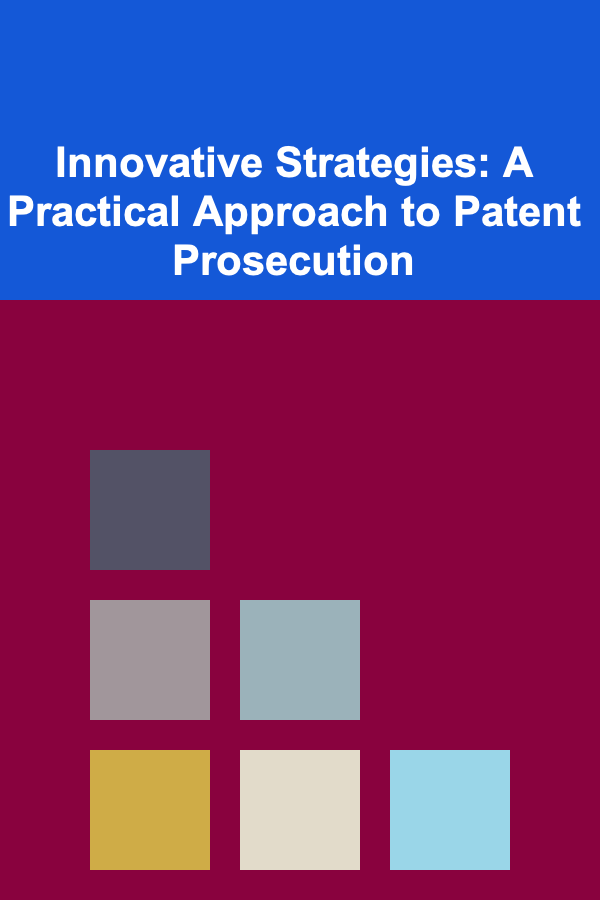
Innovative Strategies: A Practical Approach to Patent Prosecution
ebook include PDF & Audio bundle (Micro Guide)
$12.99$5.99
Limited Time Offer! Order within the next:

Patent prosecution is the process of obtaining a patent for an invention from a patent office. It involves filing an application, interacting with patent examiners, addressing rejections, and ultimately securing patent protection. A strategic approach to patent prosecution can be the difference between successfully securing valuable patent rights and facing prolonged delays, costly rejections, or a weak patent that fails to protect the invention effectively. This article explores actionable, innovative strategies for navigating patent prosecution with a focus on maximizing patent quality, minimizing risks, and ensuring that your intellectual property remains robust throughout the process.
Understanding Patent Prosecution and its Nuances
Patent prosecution isn't just about filing paperwork; it involves legal negotiation, technical analysis, and a thorough understanding of patent law. To master patent prosecution, you need to understand the stages of the process, common pitfalls, and how to handle objections and rejections.
Stages of Patent Prosecution
- Patent Application Filing: This is the initial submission of a patent application to the relevant patent office. It includes a detailed description of the invention, the claims that define its scope, drawings, and an abstract.
- Office Action Issuance: After the patent office reviews the application, it issues an office action, which may contain rejections or objections. This stage is where most of the negotiation takes place.
- Response to Office Action: The applicant responds to the office action by arguing against the rejections, amending the claims, or providing additional information to clarify the invention's novelty.
- Patent Grant: If the patent office is satisfied with the response, the application moves toward grant. However, ongoing communication may continue until the final decision is made.
Key Challenges in Patent Prosecution
- Rejection of Claims: The patent examiner may reject claims for being non-novel or obvious based on prior art. Overcoming these rejections requires careful drafting and strategic arguments.
- Obviousness Rejections: One of the most common rejections in patent prosecution is based on the argument that the invention is obvious to someone skilled in the field. This is subjective and requires persuasive evidence to counteract.
- Lack of Clarity or Support: Another frequent challenge is that claims are too vague or unsupported by the description. Ensuring precise and detailed claims is crucial to avoid such rejections.
Strategic Approaches to Drafting Claims
Drafting claims is one of the most critical aspects of patent prosecution. Claims define the boundaries of patent protection and can influence the strength and enforceability of the patent. Effective claim drafting is an art and requires a balance between broad protection and specificity.
Broad Claims vs. Narrow Claims
Broad claims provide extensive protection, covering a wide range of potential embodiments of the invention. However, they are more likely to face rejections for being vague or obvious in light of prior art. Narrow claims are easier to defend during prosecution, but they limit the scope of protection, allowing competitors to design around the invention.
Best Practices for Claim Drafting
- Use Hierarchical Claim Structure: Start with broad claims that cover the core invention and follow up with dependent claims that narrow down specific features or embodiments. This structure ensures that even if some claims are rejected, others may survive and provide protection.
- Avoid Overly Broad Claims: While broad claims can be tempting, they should not be so general that they fail to distinguish the invention from prior art. Striking a balance between breadth and specificity is key.
- Craft Claims Around Novel Features: Focus on the novel and non-obvious aspects of the invention. Avoid repeating the general knowledge that others in the field already know unless it is necessary to describe the invention's full scope.
Conducting a Thorough Prior Art Search
Before filing a patent application, a comprehensive prior art search is essential to assess the novelty and non-obviousness of the invention. A prior art search can help identify relevant patents, publications, or existing technologies that could challenge the patentability of your invention.
Why Prior Art Search is Crucial
- Identifying Potential Barriers: A thorough search helps identify prior art that might prevent the grant of a patent. It allows the patent attorney to understand potential obstacles early and address them during the prosecution phase.
- Refining Claims: By identifying the closest prior art, patent attorneys can refine the claims to distinguish the invention from existing technologies and increase the chances of success.
- Better Strategy for International Filings: Conducting an international search allows inventors to identify where their invention might already be protected in other jurisdictions, which can influence where and how to file patents.
Optimizing the Search
- Search Beyond Patents: A typical prior art search includes looking at patents, but it's essential to expand the search to include scientific publications, conference papers, product literature, and online resources.
- Use Advanced Search Tools: Leverage powerful patent databases such as Espacenet, Google Patents, and the USPTO's Global Dossier. Patent attorneys can also use commercial tools like Derwent Innovation to conduct a more thorough search.
Responding to Office Actions with Precision
Office actions are formal communications from the patent office that provide the examiner's findings and objections to the application. A strategic approach to responding to office actions can significantly impact the outcome of prosecution.
Analyzing the Office Action
- Focus on the Examiner's Reasoning: Patent attorneys should carefully read the examiner's reasoning for rejecting the claims. Understanding the basis for rejection allows for more effective counter-arguments or amendments.
- Highlighting Distinguishing Features: When responding, it's important to clearly distinguish the invention from prior art. This could involve emphasizing unique features, providing technical evidence, or explaining why the examiner's prior art selection is inappropriate.
- Engage in Examiner Interviews: In some jurisdictions, a patent attorney can schedule an examiner interview to discuss objections directly. This can help clarify misunderstandings, reduce the back-and-forth of written correspondence, and facilitate quicker resolution.
Responding with Amendments and Arguments
- Amend the Claims: Where appropriate, modify the claims to overcome the examiner's objections without unnecessarily narrowing the scope. This may involve introducing new dependent claims or redefining certain terms to provide greater clarity.
- Effective Use of Arguments: Providing persuasive arguments is often the best way to respond to rejections. This could involve demonstrating that the invention offers a non-obvious solution, or arguing that the prior art cited by the examiner doesn't adequately disclose certain elements of the invention.
Innovative Patent Prosecution Strategies
While the fundamental principles of patent prosecution remain constant, there are several innovative strategies that can make a real difference in the speed, quality, and success of patent applications.
Accelerated Patent Prosecution Programs
Many patent offices offer accelerated prosecution programs, such as the USPTO's Track One program or the European Patent Office's PACE program. These programs allow applicants to fast-track their patent applications, reducing the time it takes to secure patent protection.
Benefits of Accelerated Prosecution
- Faster Time to Market: For businesses seeking to capitalize on their inventions quickly, faster patent approval can provide a competitive edge.
- Reduced Uncertainty: Accelerating the patent process allows applicants to obtain clearer answers about their patent rights, reducing business risks.
Strategic Use of Continuations and Divisional Applications
In cases where there are multiple potential inventions within a single patent application, continuation or divisional applications can help protect additional aspects of the invention.
- Continuation Applications: These are used to pursue different claims based on the same disclosure. Continuations can help protect different variations of the invention, especially when new prior art emerges during prosecution.
- Divisional Applications: Divisional applications are used to split an application into multiple patents when different inventions are disclosed. This allows for better protection and the ability to file multiple related patents without losing the original filing date.
Global Patent Prosecution Strategy
Patent protection in multiple countries is vital for many businesses, but navigating international patent laws can be complex. Patent Cooperation Treaty (PCT) filings allow inventors to file a single international application that can later be pursued in individual countries.
Global Considerations
- Regional Filing Strategy: Depending on market needs, a company may choose to file in specific regions such as the European Union (EU) or Asia, where innovation is often driven by local competitors.
- Harmonization of Patents: Understanding how different countries harmonize their patent laws can help streamline filings. A patent attorney can help tailor filings to regional variations, such as the European Patent Convention (EPC) or the Unified Patent Court system.
Post-Grant Considerations: Protecting and Enforcing Your Patent
Once a patent is granted, it's important to actively manage and enforce your patent rights. This includes monitoring potential infringements, licensing agreements, and ensuring ongoing compliance with maintenance fee requirements.
Patent Enforcement
Patents are only as valuable as the rights they enforce. If competitors infringe upon a patented invention, it's important to take legal action to stop unauthorized use and claim damages.
- Litigation: Patent litigation involves taking action against infringement through the courts. It can be time-consuming and expensive, but it's often necessary for enforcing patent rights.
- Alternative Dispute Resolution (ADR): In some cases, negotiation, mediation, or arbitration can provide a quicker and less costly route to resolve disputes.
Licensing and Monetization
Patent licensing allows inventors or businesses to generate revenue from their inventions by granting others permission to use the technology under specified terms.
- Negotiating Licenses: Licensing agreements can be structured as exclusive or non-exclusive and may include royalty payments, lump-sum fees, or other compensation.
Conclusion
Patent prosecution is a multifaceted process that requires careful planning, strategic drafting, and effective negotiation. By employing innovative strategies such as accelerated prosecution, smart claim drafting, and leveraging global filing systems, patent applicants can maximize their chances of success. Working with experienced patent attorneys and taking a proactive approach to prosecution can ensure that patents provide meaningful, long-term protection for innovations.

Developing and Selling Pre-Trained Deep Learning Models for Profit
Read More
How to Build a Checklist for Holiday Wreath and Garland Placement
Read More
How to Motivate Yourself to Stick to a Home Cleaning Checklist
Read More
How to Set Up a DIY Dessert Bar for Your Party at Home
Read More
How to Store Books Creatively in a Small Room
Read MoreThe Branding Consultant's Blueprint: Crafting Iconic Brand Strategies
Read MoreOther Products

Developing and Selling Pre-Trained Deep Learning Models for Profit
Read More
How to Build a Checklist for Holiday Wreath and Garland Placement
Read More
How to Motivate Yourself to Stick to a Home Cleaning Checklist
Read More
How to Set Up a DIY Dessert Bar for Your Party at Home
Read More